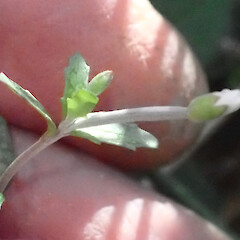Epilobium pictum
Common name
grassland willow herb
Synonyms
Epilobium haloragifolium sensu Kirk
Family
Onagraceae
Flora category
Vascular – Native
Endemic taxon
Yes
Endemic genus
No
Endemic family
No
Structural class
Herbs - Dicotyledons other than Composites
NVS code
The National Vegetation Survey (NVS) Databank is a physical archive and electronic databank containing records of over 94,000 vegetation survey plots - including data from over 19,000 permanent plots. NVS maintains a standard set of species code abbreviations that correspond to standard scientific plant names from the Ngä Tipu o Aotearoa - New Zealand Plants database.
EPIPIC
Chromosome number
2n = 36
Current conservation status
The conservation status of all known New Zealand vascular plant taxa at the rank of species and below were reassessed in 2017 using the New Zealand Threat Classification System (NZTCS) – more information about this can be found on the NZTCS website. This report includes a statistical summary and brief notes on changes since 2012 and replaces all previous NZTCS lists for vascular plants.
Please note, threat classifications are often suggested by authors when publications fall between NZTCS assessment periods – an interim threat classification status has not been assessed by the NZTCS panel.
- Conservation status of New Zealand indigenous vascular plants, 2017 . 2018. Peter J. de Lange, Jeremy R. Rolfe, John W. Barkla, Shannel P. Courtney, Paul D. Champion, Leon R. Perrie, Sarah M. Beadel, Kerry A. Ford, Ilse Breitwieser, Ines Schönberger, Rowan Hindmarsh-Walls, Peter B. Heenan and Kate Ladley. Department of Conservation. Source: NZTCS and licensed by DOC for reuse under the Creative Commons Attribution 4.0 International licence.
2017 | Threatened – Nationally Critical | Qualifiers: DP, Sp
Previous conservation statuses
2012 | Threatened – Nationally Critical | Qualifiers: DP, Sp
2009 | Threatened – Nationally Endangered | Qualifiers: DP, Sp
2004 | Data Deficient
Distribution
Endemic to the eastern side of the South Island of New Zealand.
Habitat
An uncommon, sparsely distributed species of bush margins and tussock grassland. Usually found near rock overhangs, or in semi-shaded sites.
Detailed description
Gracile, perennial herb up to 400 × 400 mm. Stems numerous, arising from a open, loosely rhizomatous root crown; stems up to 400 mm long, densely invested in ± appressed hairs, with the hairs of the inflorescence grey-strigulose. Leaves opposite, except near inflorescence where alternate, upper surface grey-green or light green with darker bluish green to dark green mottling, undersides usually reddish, petiole, leaf margins and undersides strigulose, 8.0-22.0 × 2.5-6.0 mm, narrow elliptic to elliptic, base narrowly cuneate, apex acute, margins coarsely serrate, teeth 3-6 on each side; lateral veins 2-4 each side of midrib, inconspicuous,. Inflorescence drooping bud. Flowers erect up to 9 mm diameter. Pedicel 0-3 mm long. Ovaries 7-10 mm long, grey-pubescent. Sepals not keeled, 1.8-2.3 × 0.9-1.1 mm, grey-pubescent or glabrate. Floral tube 0.6-0.9 mm deep. 1.6-1.8 mm diameter at apex, internally bearing a conspicuous ring of long white hairs. Petals white, 2.8-4.5 × 1.5-3.4 mm wide, notched, notch 0.6-0.9 mm deep. Stamens 8, of two lengths, 4 longer (1.7-2.1 mm) and 4 shorter (1.0-1.3 mm); anthers 0.5-0.7 × 0.4-0.5 mm, yellow. Style 1.2-2.0 mm long, white; stigma clavate, 1.0-1.9 × 0.4-0.5 mm. Capsules on pedicels 0.2-7.0 mm long; narrowly cylindric, 20-25 mm long, grey-pubescent. Seeds 0.9-1.1 × 0.3-0.4 mm, brown, obovoid, papillose; coma easily detached, 5-8 mm long, white.
Similar taxa
Easily distinguished from other willow herbs by the loosely rhizomatous, spreading growth habit, finely, densely pubescent stems, petioles, leaf margins and undersides, light green, distinctly mottled with dark green leaves, and flowers which are nodding in bud, erect when open.
Flowering
December - April
Flower colours
White, Yellow
Fruiting
January to July
Life cycle
Minute pappate seeds are wind dispersed (Thorsen et al., 2009).
Propagation technique
Easily grown from seed and rooted pieces of stem.
Threats
Evidently a naturally uncommon, sparsely distributed species which is now threatened at most sites by habitat loss and competition from weeds. Recent surveys suggest it has gone extinct at many sites where it had been recorded 20-30 years ago.
Etymology
epilobium: From the Greek epi- ‘upon’ and lobos ‘a pod’, the flowers appearing to be growing on the seed pod.
pictum: Painted, variegated
Where To Buy
Not Commercially Available.
Attribution
Fact sheet prepared for NZPCN by P.J. de Lange 6 January 2008. Description adapted from Raven & Raven (1976) and Webb & Simpson (2001).
References and further reading
Raven, P.H.; Raven, T.E. 1976: The genus Epilobium in Australasia. New Zealand DSIR Bulletin 216. Wellington, Government Printer.
Thorsen, M.J.; Dickinson, K.J.M.; Seddon, P.J. 2009: Seed dispersal systems in the New Zealand flora. Perspectives in Plant Ecology, Evolution and Systematics 11: 285-309.
Webb, C.J.; Simpson, M.J.A. 2011: Seeds of New Zealand Gymnosperms and Dicotyledons. Christchurch, Manuka Press.
NZPCN Fact Sheet citation
Please cite as: de Lange, P.J. (Year at time of access): Epilobium pictum Fact Sheet (content continuously updated). New Zealand Plant Conservation Network. https://www.nzpcn.org.nz/flora/species/epilobium-pictum/ (Date website was queried)








